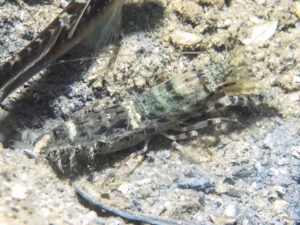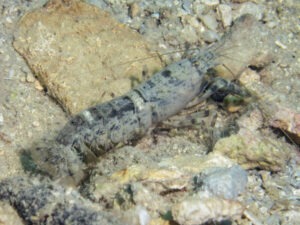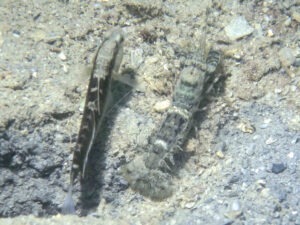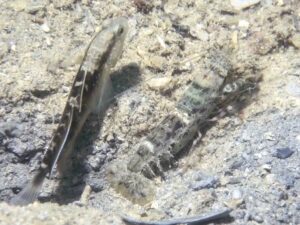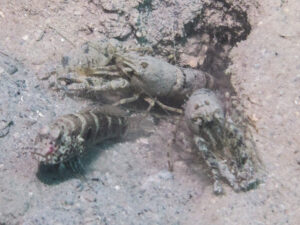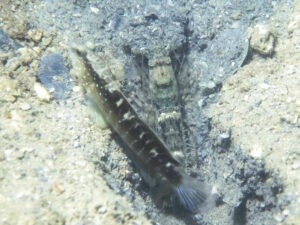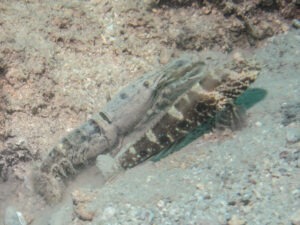Strong Snapping Shrimp
Alpheus species 13
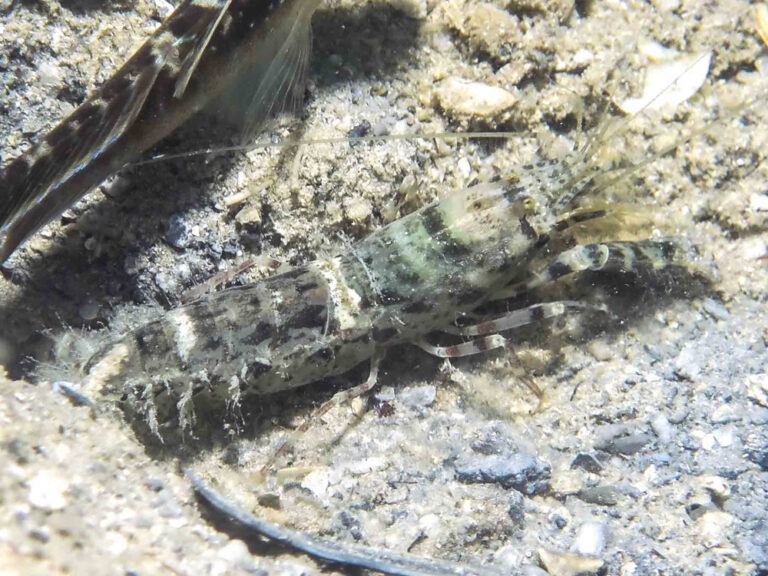
Strong Snapping Shrimp
Alpheus species 13
undescribed
Description
An unusually stocky shrimp that blends in well with the substrate. They are typically dusty and live in a silty environment. These details of the pattern are only seen on freshly moulted individuals.
Carapace: The carapace is pale grey with a pattern of dark spots and blotches. There is a transverse black band just behind the eyes. This, together with a curved band further back, encloses a pale dorsum area, usually with a dark spot in the centre. The remainder of the carapace is mottled grey with another pale transverse band further back.
The lateral aspect of the carapace is grey with darker markings and extensions of the dorsal markings making broken diagonal bands in the upper half.
The abdominal segments are pale grey. The dorsum of each segment is marked with a fine dark grey streak centrally and two randomly shaped dark grey patches laterally. There may be white bars on segments 1, 2 and 4.
The side view of the abdomen has a pattern of dark small spots and blotches. A line of bushy setae runs laterally from the carapace to the tail. This is more visible from some angles than others.
The rostrum is grey with dark grey speckling. The antennae and antennules are grey.
The pincers are pale grey with three indistinct dark bands. The two pincers are very different sizes. The second legs are grey with white joints. The walking legs are pale grey with distinct dark bands on either side of the white joints. The appendages may have setae, becoming denser distally.
The tail fan has dark grey scutes with pale centres, usually obscured by dense setae
Identifying Features
The stocky shape, usually “dusty” carapace, dark eye band and rows of setae on the abdomen are distinctive features of this shrimp.
Similar Shrimps
The Tasselled Shrimp has a plain dorsum to the carapace. The lateral aspect of the abdomen has tassels in both species, but the markings are distinctive in the Tasselled Shrimp. They occupy different habitats.
The Chocolate Chip Shrimp is similar but smaller, not as stocky and has a distinctively spotted or speckled pattern.
The Longbody Shrimp is much smaller and is readily separated by its distinctive build and markings.
Nomenclature
Undescribed species, no records found apart from ours from Australia.
Nomenclature
Undescribed species, no records apart from ours from Australia.
Ecology
HABITAT
This shallow-water species lives on the sand immediately adjacent to the sheltered fringing reef of lagoons and between adjacent bommies.
Preferred substrate
Silty sand with fine shell debris
Depth range
2 to 8 metres
Proximity to reef
Burrows are constructed between outliers of shallow fringing reefs.
NATURAL HISTORY
The body pattern and fringed construction make a perfect example of cryptic camouflage. Possibly for this reason this does not seem to be a very shy shrimp. They also live in very silty conditions which makes getting good images of them extremely difficult.
Distribution
Published distribution: none.
Our records:
Australia; Low Isles.
Associated Goby species
Associated Shrimpgobies (two species)
Cryptocentrus cyanospilotus, Bluespot Saddled Shrimpgoby
Cryptocentrus strigilliceps, Target Shrimpgoby

